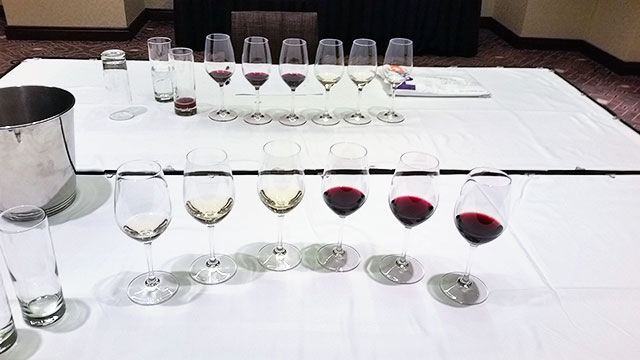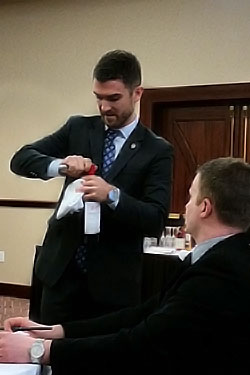Top Somm: A Look At The Central Regional Finals In Chicago
By John Lenart in Food on Mar 16, 2015 8:40PM

Wines for blind tasting at Top Somm. Photo by John Lenart.
The small hotel conference room is quiet. In the center of the room is a small table with one chair on either side. The table is set with two identical rows of six glasses of wine, three red and three white. After a few minutes in walk two men wearing suits. One sits on either side of the table. Both wear virtually identical lapel pins, except one is red with the words “Master Sommelier,” and the other is green with the words “Advanced Sommelier.”
The Master Sommelier says, “Thank you for coming. For this tasting you will have 25 minutes to identify the wines in front you. We use the Court of Master Sommeliers grid for the tasting. You'll be scored on both your observations and your conclusions of these wines however, because this is a competition your final score for this tasting will be weighted slightly more toward your conclusions. Do you have any questions?”
The Advanced Sommelier says, “No.”
The Master Somm says, “OK, your time will begin when you touch your first glass. I will tell you when you are halfway through time and again at five minutes and one minute.” The advanced sommelier takes a deep breath, looks carefully at each glass in the line-up for a moment, then reaches out and picks up the first white wine.
Thus begins the tasting portion of the Central Regional Finals of Top Somm and Top New Somm, an annual sommeliers competition held by the Guild of Sommelier. Not to be confused with the Court of Master Sommeliers, Matt Stamp MS, Director of Education for the Guild of Sommeliers explains “The Court is an accreditation organization, the Guild of Sommeliers is an educational organization.”
Now, somms tend to be a competitive bunch, and a few weeks back an informal and fun competition was held at Acanto. This event was more serious. The 12 competitors here in Chicago come from Ohio to Colorado and points in between, each qualified via an online preliminary event held in January. At stake are two $1000 scholarships, one for Top Somm, and one for Top New Somm, which is for sommeliers under 30 years old. The winner of each competition advances to the finals held in Sonoma in April, where they will compete against five other regional champions in their divisions for a $2000 scholarship and the title of Top Somm or Top New Somm.
Much like the testing for Master Sommelier, certification by the Court of Master Sommeliers, the Top Somm contest is divided into three parts; theory, blind tasting and service. The top aggregate score of all three parts wins and advances to the Top Somm finals in Sonoma in April. Top Somm central region finalists from Chicago included James Bube of Heritage Wine and Spirits, and Jon McDaniel of Acanto, The Gage and The Dawson. Top new Somm central region finalists from Chicago were Michael Elmore of The Kitchen and Alex Ring of Balena. Due to a scheduling conflict McDaniel was unable to participate.
This phase of the competition began the morning of March 8 at the Omni Hotel. It began with a written 37-question theory contest. Questions included ones like: “What is the acceptable range of residual sugar for Seco Cava?” or, “Name all AOCs a producer in Martillac would be entitled to when producing dry white wines,” and “Briefly contrast the techniques of micro-oxygenation and hyper-oxygenation in winemaking. Comment specifically on when each technique is employed.”
But there is more to being Top Somm than just wine. Other questions were from the spirits and beer world like, “Name two countries in which Ouzo may legally be produced,” and, “What is the literal translation for the following beer terms? Hefe, Wit, Saison, Weizen.”
And you better know your history and geography if you want to be Top Somm, because you'd need to know the answers to these questions: “Which national flag flew in Colmar in 1910?” or, “What geographical feature forms the northern boundary of Rutherglen GI?”
After the written theory portion of the competition, Alex Ring of Balena said, “I was able to write down more answers than I thought I would.” The chatter among the competitors afterwards focused on their concerns about the questions that pertained to topics that they hadn't specifically studied.
Shortly after the theory competition the blind tasting portion begins. Each competitor is given six wines that they must verbally analyze and come to a conclusion about where it is from, what the predominant grape variety is and which vintage it comes from.
Finally comes the service portion. Here, competitors have two tables to attend to with 12 minutes at each table. The judge at each table is a Master Sommelier. Today, competitors must show their service skills to Master Sommeliers Matt Stamp, Jesse Becker of Winebow, Serafin Alvarado of Southern Wine and Spirits and the legendary Joseph Spellman of Justin Vineyards and Winery.
This is basically a role play situation. The somm greets the “guest” and for 12 minutes is put through the grinder. “We'd like you to recommend five different rosés to pair with the following dishes: radicchio, beet and fresh ricotta salad with mandarin orange; raw geoduck clam with carrots and olio nuovo; spicy matsutake dumplings with kale; smoked cod fried rice and Tom Kha Gai.” Oh, and there were specific questions about each wine like, “What's the current vintage of that?” and, “What is the grape variety?”
Then it's followed up by, “We know your wine markup is around two and a half times, and we'd like to keep our price around $250 to $400. Which of the following wines from your list fit this budget?” The contestant is given a list of five wines which mostly fall outside the price range. After the recommendation is given the competitor is asked to provide that wine, “double decanted for three people.” That means once the wine is decanted, it is poured back into its original bottle for service. Not an easy task under the best of situations.

Mike Elmore of The Kitchen Chicago during the Service competition. Photo by John Lenart.
Spellman tells me that a good part of success here is that the somm must show an “economy of movement.” Becker adds in “If they nail the rosé pairings they'll have plenty of time for the rest.”
After running that gauntlet, you move right into another 12 minute service test. This one starts with the “guest” asking about a “Champagne” on your wine list. “What can you tell me about Jansz in the Champagne section of your wine list? It's a great price at only $25 per bottle.” Well, you had better be pretty knowledgeable to know that this isn't a champagne, but a sparkling wine made in Tazmania. If you knew the wine you'd get more questions about the “traditional method of production” and “Where in Tazmania is that made exactly?” Few got these further questions.
After presenting and pouring the “Champagne”, again under the watchful eyes of the Master Sommelier, the contestant gets questioned about whiskey. “What's the difference between Scotch and Irish whiskey?” “Which Canadian Whiskey is the top selling in the US?” “What is the proof on the Booker's Bourbon you serve?” “OK Let's have three Booker's.” One neat, two on the rocks. The server has a station set up with a variety of glassware and service items. Which glass they choose and how they serve the item is again, watched closely. All of the above must be done with grace and elegance even when the right answer isn't known.
After 24 minutes the competitors look relieved to have completed the service obstacle course. I'll tell you this, it was exhausting to just watch. I couldn't imagine having to pull that off.
An hour or so later the scores had been tabulated and at a reception Matt Stamp tells the crowd, “We know these contests are tough. We put them through the paces because it's the tough questions that separate the winners from the field. It's that close.”

Top Somm Central Region Finalists Photo by John Lenart
After a full day of wine competition the winners were announced. Andrey Ivanov (St. Louis, formerly of Elaia & Olio) as Top Somm and Austin Heidt (Boulder, Colorado, Frasca Food & Wine) as Top New Somm. They will move onto the finals in Sonoma.